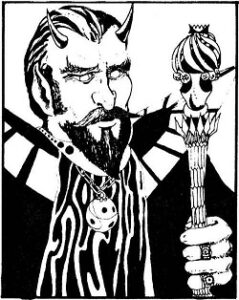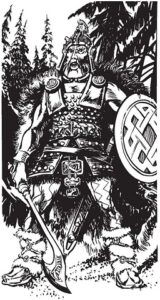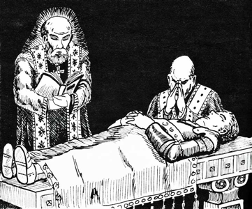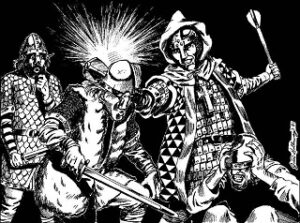Monotheism seems to be fairly uncommon in most campaign settings, but it is far more playable than one might think. I once thought that such a system would equate to boredom because it seemed to eliminate a few fantasy staples, such as friction between the gods, religious wars, and even non-violent religious rivalry—all of which generate a lot of interesting drama. Upon closer inspection, this is not the case at all.

Asmodeus: King of the Hells
Monster Manual, TSR, 1977
For starters, a monotheistic world can still have rebellious spiritual beings. Of course, Christianity has its Devil, popularly known as Lucifer or Satan, in addition to its fallen angels and/or demons. Islam has Iblis, sometimes called ash-Shaitan, in addition to its afarit (or efreet in popular gaming parlance). Judaism has its shedim (sometimes translated as demons, though they are not as prominent as in Christian writings). Thus, spiritual warfare in the Heavens or on the Prime Material Plane is still an option in a monotheistic setting. Indeed, most monotheistic religions today (at least the Abrahamic ones) paint the One God as the source of all good, meaning that any rebellious spirits are necessarily evil. Even if this were the only religious variance in your campaign setting, such a setting would still have the classic contest of good versus evil. PCs could spend their careers battling the influence of Asmodeus, Demogorgon, Orcus, and myriad others. If you wish to put your own twist on things, you could make up your own archdevil or demon lord. There are plenty of ideas to mix and match. Such a wicked spirit can give spells to evil clerics, acting as a deity in all but name. Some DMs might decide that even a powerful, rebellious spirit does not have the ability to bestow the highest-level spells, but others might reasonably decide that powerful angels and other such creatures (rebellious or not) can indeed grant all listed spells.
If you allow for more than one significant rebellious spirit, you’ll have several types of evil clerics running around in the campaign world. The DM may not wish his players to run evil characters, but at least these evil sects would provide variety among the PCs’ opponents. It is common to describe demons and devils as fighting against each other and/or amongst each other, so a wily DM can get creative in pitting evil NPC groups (followers of these wicked spirits) against one another.
In a monotheistic setting, religious wars are still possible too, perhaps against a vibrant and advanced civilization, located across the sea or on the far side of a desert or mountain range. The Crusades provide the most obvious example. From 1095 to 1291, Christians high and low were obsessed with driving the Muslims from Palestine. The two-century-long struggle was incredibly brutal, and for many Christians the outcome was disappointing, but from a story-telling point of view, the period was indescribably rich. Though the Crusaders proved themselves to be relentless, cunning, and often fearless warriors, they often found themselves outclassed in terms of manpower, logistics, and technology/engineering. How might this apply to a game setting? If a PC’s homeland is locked in an intense struggle against an advanced civilization—especially one unified by an opposing religion—dozens of plot hooks arise for the DM. A critical mind may question if such religious wars fit under the heading of monotheism, for the Crusades seem to be a contest between opposing gods. However, both Christian and Muslim writers at times described their opponents as deceived by a devil or demon. In a game setting, this can certainly be the case. There are other alternatives too. The enemy civilization’s clerics may not be ‘clerics’ in game terms. Whatever their class, they may study arcane magic instead, or they may not wield magic at all, decrying its use as the blackest of witchcraft.

Devil-worshipping Savages Make Creepy Enemies
(The Barbarian from
Unearthed Arcana,
TSR, 1985)
In a monotheistic setting, religious warfare is also possible against savage heathens on the frontier. The Northern Crusades serve as a possible example here (taking of course the Christian point of view). In the twelfth to fourteenth centuries, Roman Catholic armies, spearheaded by German crusaders, conquered the heathen tribes of northern Europe, forcibly settling Prussia and parts of the Baltic states. Crusading knights often raided deep into the gloomy trackless wilderness, sometimes becoming lost, and sometimes going mad from ‘forest cafard’. In rare cases, the heathens tied captured knights to trees and roasted them alive in their armor as sacrifices to their heathen gods. Indeed, some scholars have dubbed the Teutonic Knights’ forest campaigns in Prussia and Lithuania to be the most brutal wars in all of medieval history (which is really saying something, given the violence of the period). If you borrow this aspect for your game, the danger to the PCs lies in the barbarity of the enemy and the isolated geography of the frontier. With regard to religion, the savages in the game setting could easily worship devils/demons, thereby providing creepy foes.
Though it seems counter-intuitive, a monotheistic setting can also have great variety within the religion itself. First, a religion can have different sects, such as Christianity’s Roman Catholicism, Eastern Orthodoxy, and later Protestantism. Of course, Islam has the long-standing split between the Sunni majority and the Shi’a minority. Judaism, at least in the last few centuries, features Orthodox Judaism, Reformed Judaism, and Conservative Judaism. Historically, at least in the case of Christianity and Islam, these sects often came to blows. This provides yet another variant on religious warfare: a crusade against cultured heretics in the heartland of your civilization.
Perhaps the best example related to Christianity is the ruinous Fourth Crusade (1202-1204), in which Roman Catholic armies attacked their Eastern Orthodox cousins and sacked Constantinople itself, considered for centuries to be the bastion of Christendom. How did it get to that? A host of doctrinal issues and regional rivalry led to the Great Schism of 1054. In the century that followed, each side became bitterly disappointed with the other’s actions during the Crusades. The friction culminated in the desecration of the Hagia Sophia, the greatest church in Christendom. Meanwhile, we find another interesting example in the heartland of Western Christendom, where orthodox Roman Catholic armies launched the Albigensian Crusade, invading southern France to destroy the growing Cathar heresy there (1209-1229). The question of orthodoxy certainly took center stage, but politics, regional rivalries, and greed also played a role in the brutal campaign. For yet more examples, look to the emergence of Protestant Christianity in the sixteenth century, when accusations of heresy raged like a wildfire across Western Europe. Warfare and persecution between Catholics and Protestants reached a fever pitch, and entire kingdoms took sides. In just one example, King Philip II of Spain famously launched his vast armada in 1588 to bring all of Protestant England back into the fold (he failed).
Islam certainly suffered from sectional violence as well. Division arose immediately upon the death of the Prophet in 632, when rival camps claimed the leadership of the Faithful. Though the majority of Muslims (Sunni) hailed the first four successors (caliphs) as ‘Rightly-Guided’, the minority (Shi’a) rejected three of them, supporting only Ali, the son-in-law of Muhammad. Rejection first turned to bloodshed in 656 when Shi’a rebels assassinated the third caliph, paving the way for Ali. His ascension brought unity, but it lasted only a few years. In 661, Sunni assassins cut down Ali, and into the power vacuum stepped the wealthy Umayyad family of Syria. To maintain power, Umayyad agents supposedly poisoned Ali’s eldest son in 670, while a few thousand Umayyad soldiers slaughtered Ali’s second son and his followers in 680 at the Battle of Karbala.
The Sunni-Shi’a division only worsened in time and eventually had geopolitical ramifications. The unified caliphate vanished circa 750, when Shi’a rebellion brought an end to Umayyad rule in all but Iberia. Their victory was short-lived, for the Abbasid dynasty renounced Shi’a Islam after seizing power. However, the Shi’a later led a successful rebellion in North Africa and in 973 established a rival caliphate in Egypt, based in Cairo. The Crusaders’ initial success during the First Crusade (sometimes called the Princes’ Crusade) was as much due to Islamic division as Christian zeal and heavy cavalry. Much later, in the sixteenth and seventeenth centuries, the Ottoman Turks ruled a vast empire from Constantinople (renamed Istanbul), while the Mughals ruled much of India. Both were primarily Sunni, while the Shi’a Safavids, wedged between these two empires, ruled all of Persia. They fought for centuries. There is certainly no shortage of warfare and political infighting in a monotheistic setting.
In discussing disputes between sects of the same religion, one must wonder how that could work in a fantasy game, in which daily spells seem to be obvious proof of orthodoxy. There are several possible explanations, but the overriding theme is that divine affairs are not always clear to humans, even when there is indeed one clear and absolute truth. We have a way of being blind to that truth. We have a tendency to interpret things as we wish. One possible explanation for spells wielded by opposing sides within the same faith is that God grants spells to all of his clerics, even those that are off-track. Of course, the DM has certain ways to warn PC clerics of their deviance, even without taking away spells. There could be a chance of spell failure. Alternatively, spells might work every time but lack some potency. Alternatively, spells may work consistently and fully, but a cleric may not receive all of his allotted spells. While most PC clerics would quickly notice the above omens, NPC clerics may not, or, even if they do, they may not interpret the spell failure as an indication of their own deviance. In short, there are a many ways to explain wayward teachings of NPC clerics, so spellcasting ability should not be seen as a truth meter that would eliminate disputes.

One can also take a similar approach to divination spells, such as commune. The forthcoming answers, if they come at all, may not be as clear as clerics would like. The histories of Judaism, Christianity, and Islam are filled with examples of leaders bickering over details that God never sees fit to clarify—at least not in the manner and to the degree that they desire. Remember too that most clerics will not have access to a spell like commune, which is 5th-level (at least in AD&D). Leaders certainly will, and it seems likely that they would use such spells to answer important theological questions, but God does not always agree on the importance of our questions or the timeliness with which He must answer. Besides, however irritating it may be in life, mystery is a good thing in a game.
Despite the previous examples of religious violence, actual warfare between factions need not be the case in your monotheistic campaign setting. Perhaps things have not escalated to that point yet, or perhaps the warlike days within the faith are now over (for now). If politics is your thing, the non-violent friction between sects can be a driving force in your campaign. Religious leaders can vie for power and influence, using non-violent means. Such leaders might want to gain control of sacred scriptures, build the greatest temple in the known world, reduce the influence of rival leaders (religious or secular), and/or have their own rules and interpretations enforced. For historical inspiration here, one might look to the leading Christian cities of the first few centuries. The bishops of Rome, Antioch, Alexandria, Jerusalem and Constantinople all vied for influence in those early years. Alexandria and Antioch developed rival catechetical schools, sparring over theological issues well into the fifth century. Meanwhile, after Constantinople became the seat of the Empire in 330, the bishops of Constantinople began to challenge the traditional leadership of the bishops of Rome.
Though PC clerics are unlikely to debate theology, it is possible. A creative DM could identify one or two interesting topics that cause endless debate within the PC cleric’s religion. Rather than debating the precise nature of God, clerics in a fantasy world might argue over something of much greater interest to players, such as resurrection. Perhaps one school teaches that resurrection is indeed possible and praiseworthy, allowing God’s most favored servants to continue his work. An opposing school might teach that the faithfully departed rest forever in the arms of God, thereby denouncing resurrection magic and decrying any resurrected person to be a devil in disguise. Another interesting issue might be the faith’s stance on healing unbelievers. Is it charitable and laudable or wasteful and offensive? Whatever the controversy, the DM can decide that the issue is unresolved, allowing for either comical or tense debates between PCs and NPCs. Alternatively, one school might prevail and declare the opposing view to be heresy, forcing the PC cleric to choose a position. Such controversies are ripe for role-playing, and one can add them to a traditional fantasy game without placing undue emphasis on storytelling.

Resurrecting the Dead by David Sutherland
Players Handbook,
TSR, 1979)
Even within a single religious sect, you can provide great variety by using different branches. The Roman Catholic Church is again a good example. First you have the divide between the secular clergy (bishops, priests, and deacons) and the regular clergy (monks, friars, and nuns). For any that may be unfamiliar with the terms, the secular clergy (the term seems like an oxymoron) serves the needs of lay people, or secular people. The regular clergy developed a bit later, when devout people willingly adopted a highly regulated lifestyle (regular here meaning ‘regulated’ as compared to ‘normal’). The friction between these two branches was palpable in the thirteenth century, with the secular clerics accusing the various regular orders of insubordination and the regular clerics denouncing the worldliness of the hierarchy. In light of all that, why must a fantasy religion have only one category of clerics? Perhaps the Faith has evolved a more complicated hierarchy, composed of two or more branches, each with its own purpose. At least in the games that I’ve seen, clerics seem to do very little pastoral care. That always made me wonder. If God’s chosen clerics provided little to nothing, would the masses remain faithful? It seems unlikely. At the very least, reclaim some reality for your game by having branches of NPC clerics that see to the mundane needs of the faithful and to the administration of the temples. Perhaps a majority of clerics in your world, low-level and armed with only a few spells, spend much of their time and most of their spells caring for the flock. Certainly, throughout Western Europe, a constant stream of sick and infirm pilgrims visited churches to receive blessings and healing. Clerical branches in your world need not mirror those of the Roman Church (secular and regular) but adopting such a division does give you a very rich model.
Diving even deeper, we find great variety in the regular clergy itself. This arose organically, as specific needs led to the creation of different religious orders. For example, in the eleventh and twelfth centuries, the various religious-military orders (Templars, Hospitallers, Teutonic Knights, etc.) sprang up to safeguard Christian pilgrims and to defend the Crusader states in Outremer. In the thirteenth century, several mendicant (begging) orders arose as a reaction against the perceived worldliness in the monasteries, and even these new mendicant orders had their special niches. For example, the Roman Church created the Order of Friars Minor (Franciscans or ‘Gray Friars’) largely to contain popular mysticism, for many were dangerously close to heresy, and the order gave such men an outlet that was still within the pale of orthodoxy. The Order of Preachers (Dominicans or ‘Black Friars’) specialized in theology and preaching, which explains why its members increasingly staffed the Holy Office of the Inquisition, designed to combat heresy. In the sixteenth century, when the existing orders seemed powerless to stop the perceived Protestant heresy, the Roman Church developed the Society of Jesus (Jesuits), providing the Pope with highly educated ‘stormtroopers’, whose very name soon became a byword for loyalty to Rome (at least until the twentieth century).
Even regular orders that had no official specialty eventually gravitated towards one. Consider the contemplative Benedictine monks (‘Black Monks’), who were by far the most common type of monk in Western Europe for several centuries. Those affiliated with the abbey at Cluny in France, at the height of their influence in the twelfth century, became known for their vast agricultural estates (which gave them political independence) and their utter devotion to liturgy. These ‘soldiers of Christ’ waged a spiritual battle for the salvation of their souls and those of their patrons, performing almost constant prayer at Cluny Abbey. To a degree, their militant rhetoric paved the way for the true military orders, whose members fought with swords rather than psalters. We see another example of specialization among Benedictines in the twelfth century. The monks at Citeaux Abbey in France began a reform movement that stressed strict discipline and hard labor. These Cistercians (‘White Monks’) often sought isolation on remote estates in the mountains or on the moors, and yet their industry and hard work gave them a reputation as pioneers.
Think of how easily one could use this basic framework to create a dozen fantasy religious orders within a single sect, each with its own focus, domain spells, unique spells, and mission statement. You might have one or more military orders, an order that focuses on prayer, one that focuses on healing and administering hospitals (hospitallers), one that focuses on preserving books, another that focuses on missionary work, another that excels at taming the wilderness, and yet another that is renowned for its orthodoxy and its skill in ferreting out heretics. The sky’s the limit. If you wish to capture the flavor of an old and sprawling religion, create significant overlap between orders and set them up as rivals (in most hierarchies, overlap usually occurs when new groups form and take on the role of older ones, without actually eliminating them).

Pax Vobiscum
by Jim Holloway
(Dragon magazine 52, TSR, August 1981)
It’s fun to present the PCs with two lawful good groups that despise each other. For an historical example, consider the petty War of St. Sabbas (1256-1270), in which rival Italian cities fought each other near Acre. Events drew Templars and Hospitallers into the conflict, and their long-standing rivalry (they both filled the same niche), may have actually come to blows. Even Gary Gygax inserted this strange dynamic into his games when he created the first gods for his home-brew campaign. When his players demanded gods for their clerics to worship, he eventually gave them two rival lawful good religions, pitting the followers of St. Cuthbert against those of Pholtus of the Blinding Light. Followers of St. Cuthbert were fond of thumping dissenting fools on their heads with clubs, while clerics of Pholtus had a tendency to blind infidels with a light spell between the eyes. Even a simple arrangement like that makes for wonderful non-lethal drama.
So, what’s not to love about monotheism in a game setting? History provides myriad examples of classic spiritual warfare (‘good versus evil’), religious warfare, factional rivalry, and non-violent competition even within a single religion. Despite its viability, I don’t really expect DMs to adopt a monotheistic setting, but perhaps some of the above ideas may help you to flesh out a few of the main religions in your existing campaign setting. Variety is always nice, and, strangely, we can get more of it by borrowing from monotheistic organizations.
